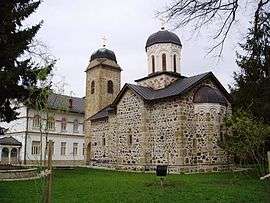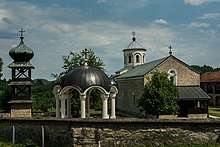Eparchy of Zvornik and Tuzla
| Eparchy of Zvornik and Tuzla | |
|---|---|
| Location | |
| Territory | North-eastern parts of Bosnia and Herzegovina |
| Headquarters | Bijeljina, Bosnia and Herzegovina |
| Information | |
| Denomination | Eastern Orthodox |
| Sui iuris church | Serbian Orthodox Church |
| Established | 15th Century |
| Language |
Church Slavonic Serbian |
| Current leadership | |
| Bishop | Fotije Sladojević |
| Map | |
-en.svg.png) | |
| Website | |
| http://www.eparhijazt.com/ | |



The Eparchy of Zvornik and Tuzla (Serbian: Епархија зворничко-тузланска) is an eparchy of the Serbian Orthodox Church with its seat in Bijeljina, Bosnia and Herzegovina. It has jurisdiction over the north-eastern regions of Bosnia and Herzegovina. Since 2017, Bishop of Zvornik and Tuzla is Fotije Sladojević.[1]
History
In the north-eastern parts of Bosnia and Herzegovina, on the territory of the present day Eparchy of Zvornik and Tuzla, there are several archeological localities that indicate the presence of early Christianity in that region during late Roman period and early Middle Ages. Since 1284, the region came under the rule of Serbian king Stefan Dragutin and soon after that an Eastern Orthodox Bishop Vasilije was appointed for all Bosnian regions, western of the river Drina.[2] During the reign of Serbian Despots Stefan Lazarević (1389-1427) and Đurađ Branković (1427-1456), much of the north-eastern Bosnia was again under Serbian rule.[3] During that time, the foundation was laid for the establishment of an Eastern Orthodox Eparchy in that region, under the jurisdiction of the Serbian Patriarchate of Peć.
By the end of 15th century much of the region was conquered by Ottoman Turks who organized the territory into a province called the Sanjak of Zvornik. Between 1526 and 1541, during the attempt of Metropolitan Pavle of Smederevo to restore the Serbian Patriarchate of Peć, Eparchy of Zvornik and its bishop Teofan were also included in local ecclesiastical disputes with Archbishopric of Ohrid.[4] Finally in 1557, Serbian Patriarchate of Peć was restored and the Eparchy of Zvornik was returned to its jurisdiction, with bishops of Zvornik holding the honorary title of metropolitan.[5]
In 1766, when Serbian Patriarchate of Peć was abolished, the Eparchy of Zvornik and all other Serbian eparchies under Ottoman rule came under the jurisdiction of Ecumenical Patriarchate of Constantinople. Bishop of Zvornik kept his honorary title of Metropolitan, as was also the custom in the Ecumenical Patriarchate. By the end of 18th century and during much of 19th century, bishops of this Eparchy resided in the city of Tuzla. Since 1878, territory of Bosnia and Herzegovina was under the occupation of Austria-Hungary, but under the Church Convention of 1880 all Eastern Orthodox eparchies remained under supreme ecclesiastical jurisdiction of Ecumenical Patriarchate of Constantinople. At the end of the First World War in 1918, all Serbian Orthodox bishops in Bosnia and Herzegovina reached a unanimous decision to join with other Serbian ecclesiastical provinces into united Serbian Orthodox Church. The process of unification was completed in 1920 and since then Eparchy of Zvornik and Tuzla remains part of the united Serbian Orthodox Church.[6]
Heads
This is an incomplete list of bishops and metropolitans of Zvornik.
- Teofan (1532—1541)
- Pavle (around 1561-1576)
- Georgije (end of 16th century)
- Teodisije (around 1601—1602)
- Gavrilo (died 1627)
- Konstantin (around 1629)
- Luka (sometime during 17th century)
- Venijamin (sometime during 17th century)
- Isaija (sometime during 17th century)
- Ananija (around 1674)
- Gerasim (beginning of 18th century)
- Grigorije (1767—1773)
- Gerasim (1776—1804)
- Joanikije (1804—1807)
- Evgenije (1807-1808)
- Gavrilo (1808—1837)
- Kiril (1837—1848)
- Agatangel (1848—1858)
- Dionisije I (1861—1865)
- Dionisije II (1865—1891)
- Nikolaj Mandić (1892—1897)
- Grigorije Živković (1897—1909)
- Ilarion Radonić (1910—1921)
- Nektarije Krulj (1929—1955)
- Longin Tomić (1955—1977)
- Vasilije Kačavenda (1978—2013)
- Hrizostom Jević (2013-2017)
- Fotije Sladojević (2017-present)
Monasteries
See also
References
- ↑ Communique of the Holy Assembly of Bishops (2017)
- ↑ Kašić 1975, pp. 35.
- ↑ Ćirković 2004, pp. 51.
- ↑ Нилевић 1990, pp. 131-139.
- ↑ Sotirović 2011, pp. 143-169.
- ↑ Kiminas 2009, pp. 22, 28.
Bibliography
- Kašić, Dušan, ed. (1975). Serbian Orthodox Church: Its past and present. 5. Belgrade: Serbian Orthodox Church.
- Нилевић, Борис (1990). Српска православна црква у Босни и Херцеговини до обнове Пећке патријаршије 1557. године (Serbian Orthodox Church in Bosnia and Herzegovina before the renewal of the Patriarchate of Peć in 1557). Сарајево: Веселин Маслеша.
- Вуковић, Сава (1996). Српски јерарси од деветог до двадесетог века (Serbian Hierarchs from the 9th to the 20th Century). Евро, Унирекс, Каленић.
- Bataković, Dušan T. (1996). The Serbs of Bosnia & Herzegovina: History and Politics. Dialogue Association.
- Mileusnić, Slobodan (1997). Spiritual Genocide: A survey of destroyed, damaged and desecrated churches, monasteries and other church buildings during the war 1991-1995 (1997). Belgrade: Museum of the Serbian Orthodox Church.
- Ćirković, Sima (2004). The Serbs. Malden: Blackwell Publishing.
- Kiminas, Demetrius (2009). The Ecumenical Patriarchate: A History of Its Metropolitanates with Annotated Hierarch Catalogs. Wildside Press LLC.
- Sotirović, Vladislav B. (2011). "The Serbian Patriarchate of Peć in the Ottoman Empire: The First Phase (1557–94)". Serbian Studies: Journal of the North American Society for Serbian Studies. 25 (2): 143–169.

